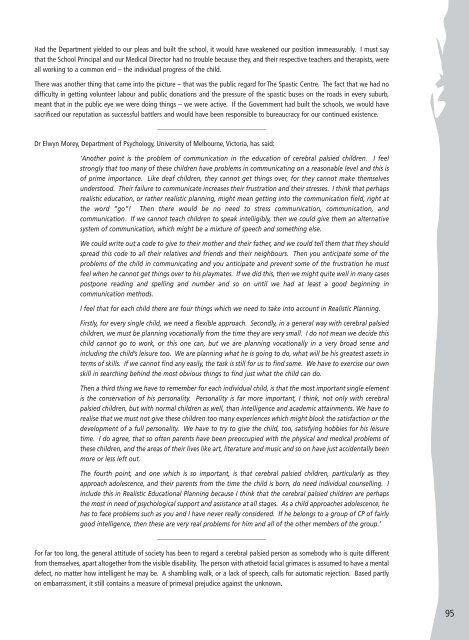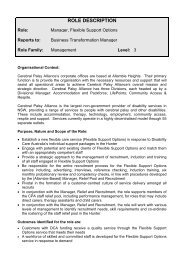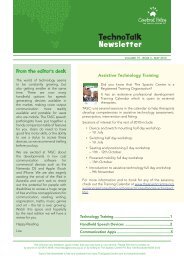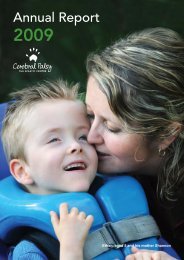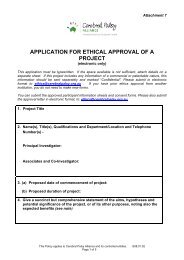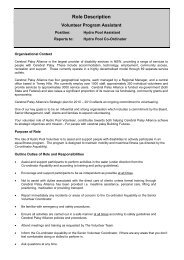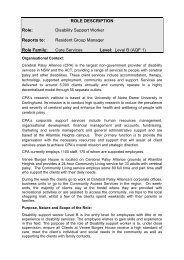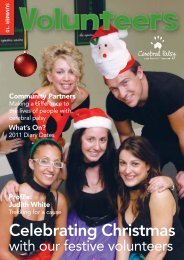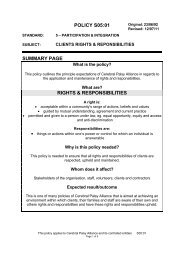'Nothing is impossible' - Part 2, chapter 4-8 - The Spastic Centre
'Nothing is impossible' - Part 2, chapter 4-8 - The Spastic Centre
'Nothing is impossible' - Part 2, chapter 4-8 - The Spastic Centre
You also want an ePaper? Increase the reach of your titles
YUMPU automatically turns print PDFs into web optimized ePapers that Google loves.
Had the Department yielded to our pleas and built the school, it would have weakened our position immeasurably. I must say<br />
that the School Principal and our Medical Director had no trouble because they, and their respective teachers and therap<strong>is</strong>ts, were<br />
all working to a common end – the individual progress of the child.<br />
<strong>The</strong>re was another thing that came into the picture – that was the public regard for <strong>The</strong> <strong>Spastic</strong> <strong>Centre</strong>. <strong>The</strong> fact that we had no<br />
difficulty in getting volunteer labour and public donations and the pressure of the spastic buses on the roads in every suburb,<br />
meant that in the public eye we were doing things – we were active. If the Government had built the schools, we would have<br />
sacrificed our reputation as successful battlers and would have been responsible to bureaucracy for our continued ex<strong>is</strong>tence.<br />
______________________________<br />
Dr Elwyn Morey, Department of Psychology, University of Melbourne, Victoria, has said:<br />
‘Another point <strong>is</strong> the problem of communication in the education of cerebral palsied children. I feel<br />
strongly that too many of these children have problems in communicating on a reasonable level and th<strong>is</strong> <strong>is</strong><br />
of prime importance. Like deaf children, they cannot get things over, for they cannot make themselves<br />
understood. <strong>The</strong>ir failure to communicate increases their frustration and their stresses. I think that perhaps<br />
real<strong>is</strong>tic education, or rather real<strong>is</strong>tic planning, might mean getting into the communication field, right at<br />
the word “go”! <strong>The</strong>n there would be no need to stress communication, communication, and<br />
communication. If we cannot teach children to speak intelligibly, then we could give them an alternative<br />
system of communication, which might be a mixture of speech and something else.<br />
We could write out a code to give to their mother and their father, and we could tell them that they should<br />
spread th<strong>is</strong> code to all their relatives and friends and their neighbours. <strong>The</strong>n you anticipate some of the<br />
problems of the child in communicating and you anticipate and prevent some of the frustration he must<br />
feel when he cannot get things over to h<strong>is</strong> playmates. If we did th<strong>is</strong>, then we might quite well in many cases<br />
postpone reading and spelling and number and so on until we had at least a good beginning in<br />
communication methods.<br />
I feel that for each child there are four things which we need to take into account in Real<strong>is</strong>tic Planning.<br />
Firstly, for every single child, we need a flexible approach. Secondly, in a general way with cerebral palsied<br />
children, we must be planning vocationally from the time they are very small. I do not mean we decide th<strong>is</strong><br />
child cannot go to work, or th<strong>is</strong> one can, but we are planning vocationally in a very broad sense and<br />
including the child’s le<strong>is</strong>ure too. We are planning what he <strong>is</strong> going to do, what will be h<strong>is</strong> greatest assets in<br />
terms of skills. If we cannot find any easily, the task <strong>is</strong> still for us to find some. We have to exerc<strong>is</strong>e our own<br />
skill in searching behind the most obvious things to find just what the child can do.<br />
<strong>The</strong>n a third thing we have to remember for each individual child, <strong>is</strong> that the most important single element<br />
<strong>is</strong> the conservation of h<strong>is</strong> personality. Personality <strong>is</strong> far more important, I think, not only with cerebral<br />
palsied children, but with normal children as well, than intelligence and academic attainments. We have to<br />
real<strong>is</strong>e that we must not give these children too many experiences which might block the sat<strong>is</strong>faction or the<br />
development of a full personality. We have to try to give the child, too, sat<strong>is</strong>fying hobbies for h<strong>is</strong> le<strong>is</strong>ure<br />
time. I do agree, that so often parents have been preoccupied with the physical and medical problems of<br />
these children, and the areas of their lives like art, literature and music and so on have just accidentally been<br />
more or less left out.<br />
<strong>The</strong> fourth point, and one which <strong>is</strong> so important, <strong>is</strong> that cerebral palsied children, particularly as they<br />
approach adolescence, and their parents from the time the child <strong>is</strong> born, do need individual counselling. I<br />
include th<strong>is</strong> in Real<strong>is</strong>tic Educational Planning because I think that the cerebral palsied children are perhaps<br />
the most in need of psychological support and ass<strong>is</strong>tance at all stages. As a child approaches adolescence, he<br />
has to face problems such as you and I have never really considered. If he belongs to a group of CP of fairly<br />
good intelligence, then these are very real problems for him and all of the other members of the group.’<br />
______________________________<br />
For far too long, the general attitude of society has been to regard a cerebral palsied person as somebody who <strong>is</strong> quite different<br />
from themselves, apart altogether from the v<strong>is</strong>ible d<strong>is</strong>ability. <strong>The</strong> person with athetoid facial grimaces <strong>is</strong> assumed to have a mental<br />
defect, no matter how intelligent he may be. A shambling walk, or a lack of speech, calls for automatic rejection. Based partly<br />
on embarrassment, it still contains a measure of primeval prejudice against the unknown.<br />
95


